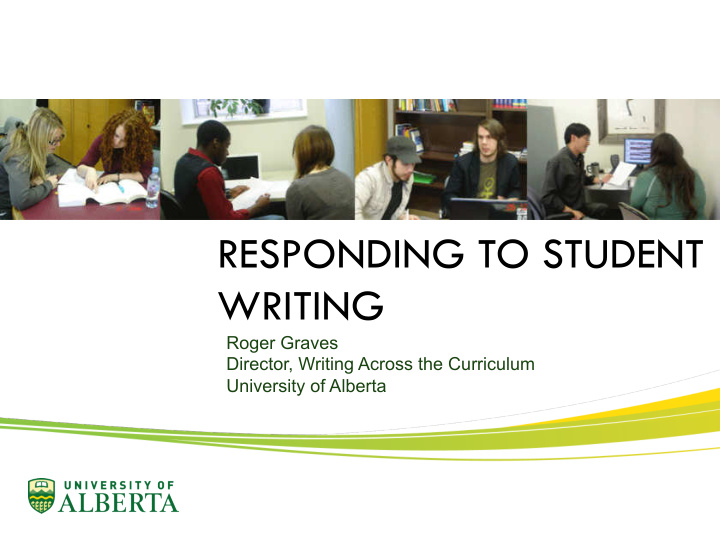



RESPONDING TO STUDENT WRITING Roger Graves Director, Writing Across the Curriculum University of Alberta
Roger Graves http://www.ualberta.ca/~graves1/
Writing Across the Curriculum http://wac.ctl.ualberta.ca/
Response Response can come at any stage of the writing process: • Thesis statements (idea generation) • Outlines (organization) • Drafts (coherence, development) • Final/finished products (editing, proofreading) • At each stage, the focus of the response should change.
The Writing Process: A Model Share, Reflect/enjoy Identify a Retool/enjoy talk project Resume/engage Research, Draft, refine, Read, write revise Note the recursive nature of Research can the process happen at all stages of writing
Summative/Formative = Summative evaluation/response sums up, totals, gives a final comment on a performance + Formative evaluation helps shape or form the performance in advance of a final judgment of it
Sample peer response questions Peer Feedback: Proposal Writing 1. Identify the main claims made in the proposal. 2. Using the schema on pages 114-115, identify the claim, link (because statement), reason, and evidence that are explicit or implicit in at least one of these claims. 3. Identify a rebuttal (challenge) that someone might make to one of these arguments, and then suggest how the writer could counter that rebuttal. 4. Using the proposal evaluation sheet as a guide, identify 3 areas you think the writer could improve if they revised their proposal.
Who responds? • Peers in class • Centre for Writers tutors • Friends, family • Instructor
Principles of response • Respond to encourage revision rather than justify a grade • Organize your comments into a hierarchy—most important to least important • Comment on ideas and organization first • Wherever possible, make positive comments • Avoid over-commenting: students learn faster if they must find and correct their own errors Bean, John C. Engaging Ideas: The Professor ’ s Guide to Integrating Writing, Critical Thinking, and Active Learning in the Classroom . San Francisco: Jossey-Bass, 2001.
How to respond, 1 • Do not waste time on careless student work. • Do not extensively mark grammar and punctuation. • Address fundamental concerns first. • Consider comments without grades. • Use comments only for teachable moments. • Spend more time guiding. • Use only as many grade levels as you need (2= p/f to 13). • Limit the basis for grading. Walvoord, Barbara E. and Virginia Johnson Anderson. Effective Grading: A tool for Learning and Assessment in College . 2 nd ed. San Francisco: Jossey-Bass, 2010.
How to respond, 2 Higher-order concerns • Does the draft follow the assignment? • Does the writer have a thesis that addresses an appropriate problem or question? • If the draft has a thesis, what is the quality of the argument itself? • Is the draft organized effectively at the micro level? • Lower-order concerns • Are there stylistic problems that you find particularly annoying? • Is the draft free of errors in grammar, punctuation, and spelling? Bean, John C. Engaging Ideas: The Professor ’ s Guide to Integrating Writing, Critical Thinking, and Active Learning in the Classroom . San Francisco: Jossey-Bass, 2001.
Metaphors for response Coach • Uses writing workshops to draft and revise student work in class • Believes praise works better than censure • Depends upon students to take responsibility for their own learning Source: Stephen W. Wilhoit, The Longman Teaching Assistant ’ s Handbook: A Guide for Graduate Instructors of Writing and Literature. New York: Pearson Longman, 2008.
Metaphors for response Editor • Focus on sentence-level errors • Conversant with rules and conventions of standard edited English • Every word and punctuation mark counts • Devote much time marking essays Source: Stephen W. Wilhoit, The Longman Teaching Assistant ’ s Handbook: A Guide for Graduate Instructors of Writing and Literature. New York: Pearson Longman, 2008 .
Metaphors for response Academic reader • Focus on how well the paper meets the standards of academic discourse for style, evidence, citations, sources • If not, what must be changed? Source: Stephen W. Wilhoit, The Longman Teaching Assistant ’ s Handbook: A Guide for Graduate Instructors of Writing and Literature. New York: Pearson Longman, 2008.
Metaphors for response Average reader Read as if you were reading a magazine or newspaper—to see what the writer has to say Speak back to the writer about what interests you, confuses you, annoys you Source: Stephen W. Wilhoit, The Longman Teaching Assistant ’ s Handbook: A Guide for Graduate Instructors of Writing and Literature. New York: Pearson Longman, 2008.
Metaphors for response Customs officer • Guards the academic border to ensure only approved students pass on • Works from a clear set of rules • Applies the rules consistently
Your turn Which of these metaphors describes how you see yourself as a responder to student writing? Is there another metaphor that captures what you are trying to accomplish when you respond to student writing?
Sources Coach photo: http://picasaweb.google.com/lh/photo/T4NhrhxVWMh8qfkL2NbmUw Border shot: http://farm1.static.flickr.com/52/131161403_afb1b40c45.jpg Edmonton Journal: http://www.edmontonjournal.com/ Editing: http://images.google.ca/imgres?imgurl=http://farm3.static.flickr.com/
Recommend
More recommend